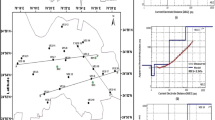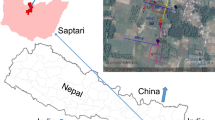Abstract
Vertical electrical resistivity soundings were conducted in order to delineate groundwater potential aquifers in Peddavanka watershed, which is a catchment of about 398 km2 in Anantapur District, Andhra Pradesh, India. The main lithologic units in the watershed are quartzite, limestone, shale, and alluvium. Ninety-nine vertical electrical soundings were conducted using the Schlumberger configuration, covering the entire watershed. The data were interpreted with the help of master curves and auxiliary point charts. Interpretations of VES were used to generate a top layer apparent resistivity contour map and longitudinal conductance map. Isoresistivity contour maps were prepared and interpreted in terms of resistivity and thickness of various sub-surface layers using computer software (SURFER), and isocontour diagrams depicting the depth to bedrock were prepared. Resistivity results were correlated with the existing lithology. Based on the depth to bedrock, the thickness of the saturated layer and the resistivity of the second layer, a groundwater potential map has been prepared, in which good, moderate, and poor zones are classified. The study reveals that the weathered and fractured portions in shale and limestone that occur in the southernmost and central portions of the watershed area constitute the productive water-bearing zones categorized as good groundwater potential aquifers.












Similar content being viewed by others
References
Appa Rao A (1997) Developments in geoelectrical methods. AA Balkema, Rotterdam, The Netherlands, p 293
Bhattacharya PK, Patra HP (1968) Direct current geoelectric sounding – principles and interpretation. Elsevier, New York, p 135
Bhimasankaram VLS, Gaur VK (eds)(1977) Lectures on exploration geophysics for geologists and engineers. Assoc Explor Geophysicists, Centre Explor Geophys, Hyderabad, India
Keller GV, Frischknecht FC (1966) Electrical methods in Geophysical prospecting. Pergamon, London, p 517
Orellana E, Mooney HM (1966) Master tables and curves for vertical electrical sounding over layered structures. Interciencia, Madrid, Spain, p 150 (66 tables)
Rijkswaterstaat (1969) Standard graphs of resistivity prospecting. Europ Assoc Explor Geophys, The Hague, The Netherlands, pp 125–140
Singh VS, Jain SC, Rao TV, Rao MN, Negi BC (2003) Groundwater targeting in a shaly limestone terrain: an integrated approach. J Geol Soc India 62(6):769–772
Todd DK (1995) Groundwater hydrology. Wiley, New York, p 538
Yadav GS, Lal T (1989) Investigation of groundwater resources at selected levels in drought prone area of Pahari block, Mirzapur District, U.P., India. In: Int Workshop Approp Methodol Development Management Groundwater Res Dev Countries, Vol 1. NGRI, Hyderabad, India, 28 February–4 March 1989, pp 209–219
Yungul SH (1996) Electrical methods in geophysical exploration of sedimentary basin. Chapman and Hill, U.K.
Zhdanov SM, Keller GV (1994) The geoelectrical methods in geophysical exploration. Elsevier, Amsterdam, The Netherlands
Zohdy AAR, Eaton GP, Mabey DR (1974) Application of surface geophysics to groundwater investigations. In: Zohdy AAR, Eaton GP, Mabey DR (eds) Techniques of water resources investigations of the United States Geological Survey. US Government Printing Office, Washington, DC, Book 2, Chap D1, p 116
Acknowledgements
I gratefully acknowledge Dr. V.P. Dimri, Director of NGRI, for his constant encouragement and consent to publish this work. I wish to express my gratitude to Dr. P.K. Govil, Sri. G.L.N. Reddy and Dr. N.N. Murthy, Environmental Geochemistry Division, NGRI, for their constructive comments and useful suggestions. I owe my deep sense of indebtedness to Dr. A.S. Sudheer, Dept. of Geology and Dr. S. Srinivasulu, Dept. of Geography, S.V. University, Tirupati for their worthy guidance with their untiring initiative in completion of this work. I wish to extend my sincere thanks to Sri. A. Chakravarthi, NGRI, for his sagacious suggestions and for improving the quality of work. The financial assistance provided by the Council of Scientific and Industrial Research (CSIR), New Delhi, through the award of my Research Associate fellowship is gratefully acknowledged. I also thank anonymous reviewers for their constructive review of the manuscript and for editorial revision.
Author information
Authors and Affiliations
Corresponding author
Rights and permissions
About this article
Cite this article
Srinivasa Gowd, S. Electrical resistivity surveys to delineate groundwater potential aquifers in Peddavanka watershed, Anantapur District, Andhra Pradesh, India. Env Geol 46, 118–131 (2004). https://doi.org/10.1007/s00254-004-1023-2
Received:
Accepted:
Published:
Issue Date:
DOI: https://doi.org/10.1007/s00254-004-1023-2




